Customer service staff in the Montesano Regional Office are available for walk-in service 9 a.m. to 4 p.m. Monday through Friday excluding legal holidays.
The Port Townsend District Office is open by appointment only. Please call 360-302-3030 to schedule an appointment.
48 Devonshire Road
Montesano, WA 98563
United States
Fishing tips and news
New to fishing in Washington? Check out our Fish Washington blog post for a guide on how to get started.
2024-25 Sport Fishing Rules
The 2024-25 Washington Sport Fishing Rules pamphlet is now available online and at hundreds of license dealers around the state.
Current fishing regulations and emergency Fishing Rule Changes are also available online at wdfw.wa.gov/fishing/regulations.
More recreational razor clam digs approved
November will kick off with razor clam digging opportunities at Long Beach, Twin Harbors, Copalis, and Mocrocks beaches.
Evening digs have been approved for Nov. 1-5. Additional dates are tentatively scheduled through December, pending Washington Department of Health testing for marine toxins. Find a list of tentative dates and razor clam regulations in our latest news release.
In early fall beaches still have a lot of sand built up, which can make driving hazardous. WDFW asks diggers to drive carefully on the uppermost part of the hard-packed sand, avoid wet sand, and not to create congestion leading on and off the beach by parking on the approaches.
WDFW biologists and scientific technicians, in collaboration with Quinault Indian Nation and the Hoh Tribe, conducted our annual razor clam stock assessments over the summer. Learn more about how we balance recreational razor clam harvest opportunities with protecting the resource in our blog post.
Orange coloration in shellfish is not a safety concern
WDFW has recently received reports of orange spots or stains in razor clams along coastal beaches and oysters in Willapa Bay and Grays Harbor. These shellfish are not changing colors like the fall leaves, nor are they pumpkin spice flavored!
The orange coloration is due to a bloom of the naturally occurring dinoflagellate (plankton) Tripos spp. that has been observed off the Washington Coast since early October. This plankton is commonly found in water samples, though large blooms are less common. In fact, the last time a large-scale bloom of Tripos spp. was found off the Washington Coast was in 1995!
Current ocean conditions have been favorable for dinoflagellate growth, though recent samples have shown drastically decreased amounts of Tripos spp.
Luckily, there is no concern for shellfish health, and oysters and razor clams with orange coloring are still safe to eat. WDFW will continue to monitor coastal waters for any changes in collaboration with the Olympic Region Harmful Algal Blooms Partnership.
Coastal steelhead virtual town hall set for Nov. 13
WDFW will host its second virtual town hall meeting on the 2024-25 coastal steelhead season at 6 p.m. Nov. 13.
Fish Program staff will share agreed-to fishery plans with the public during the meeting. In late November, the Department will finalize those plans with tribal co-managers and then announce the 2024-25 season and regulations.
Members of the public can participate in the Nov. 13 meeting through Zoom, either online or by phone. Meeting materials and information on fishery management, including past town halls, are available on WDFW’s coastal steelhead management webpage.
Staff will present finalized plans to the Washington Fish and Wildlife Commission in a special Fish Committee meeting in November. More information will soon be available on the Commission’s meeting webpage.
Saltwater fishing remains open in several areas
Several areas remain open for coho and chum salmon, including eastern Grays Harbor and Willapa Bay (Marine Areas 2-2 and 2-1), and central and south-central Puget Sound (Marine Areas 10 and 11 are open through Nov. 15). South Puget Sound (Marine Area 13) is open for hatchery Chinook and coho. Hood Canal (Marine Area 12) is open for chum from Nov. 1-30. The Westport Boat Basin and Ocean Shores Boat Basin are open for coho.
Be sure to watch the weather and water conditions and bring adequate clothing and safety equipment when heading out this time of year. Sea run coastal cutthroat fishing in South Puget Sound and Hood Canal can also be exceptional this time of year as waters cool.
Crabbing continues on the coast, reopens in Puget Sound
Recreational crabbing is open year-round in the coastal management area, though gear restrictions are in place during the fall months. Information on crabbing on the Washington coast, Grays Harbor, Willapa Bay, and the Columbia River estuary is available on the coastal crabbing webpage.
Pot gear season is closed through Nov. 14 in Willapa Bay and through Nov. 30 in Grays Harbor and along the outer coast. Learn more about this annual closure, affected areas, and other crabbing regulations in this blog post: Check your gear: here’s what’s legal during crab pot closure in coastal marine areas.
Puget Sound marine areas are open daily for winter recreational crab fishing through Dec. 31. Waters reopening to sport crabbing include marine areas 4, 5, 6, 7, 8-1, 8-2, 9 and only the portion of 12 north of Ayock Point. Find more information, including rules and regulations, in our latest news release.
Release "stitched" smallmouth bass in the Chehalis River
WDFW is radio tagging smallmouth bass as part of ongoing efforts to monitor non-native predatory fish in the Chehalis River.
If you catch a smallmouth bass with belly sutures and/or a radio antenna, please release it so we can continue studying these fish. Fish Program staff radio tagged 120 smallmouth bass in the mainstem Chehalis this past spring and hope to continue studying them for the next year.
Learn more about smallmouth bass and how to fish for them on our webpage. Anglers should also review the Washington Sport Fishing Rules pamphlet or Fish Washington mobile app before heading out.
New fishing regulations in effect at Minter Creek
This year all waters within channels created by exposed tidelands are closed to fishing at Minter Creek in Pierce County as part of new regulations for the 2024-25 season. Learn more in our news release.
Salmon fishing is open through Dec. 31, from the mouth of the creek at Carr Inlet to markers located approximately 50 feet downstream of the Minter Creek Hatchery rack.
The new rule means anglers cannot fish in exposed channels of the creek on tidal flats during low tides. They must fish the mainstem of the creek above the high tide line where it is publicly accessible, or in the larger saltwater as the tide floods over the tide flats, filling the bay. Anglers should avoid trespassing on private tidelands.
Releasing salmon properly
Selective fisheries for hatchery-produced salmon and catch-and-release fisheries are increasingly important to providing recreational fishing opportunities around Washington. To ensure these salmon fisheries are successful long-term, it is vital that anglers do their part to comply with all regulations, especially how to properly release unmarked and out-of-season fish to improve their survival.
For more information, watch our YouTube video on safe salmon handling or read our blog post about how to properly release salmon.
Snagging fish is illegal in Washington
Fishing legally and ethically helps to ensure an enjoyable time for everyone.
WDFW would like to remind all anglers that snagging is illegal throughout Washington. Snagging is defined in WAC 220-300-160 as “an effort to take fish with a hook and line in a manner that the fish does not take the hook or hooks voluntarily in its mouth.”
Although more commonly witnessed during times of low flow, snagging occurs year-round. Violators are subject to fines or prosecution under RCW 77.15 or other applicable laws and regulations.
Check out our video to learn more, and help spread the word about protecting our state’s fish resources.
Clean, drain, dry your boat to prevent the spread of invasive species!
Help prevent the spread of aquatic invasive species by having your boat checked every time you pass a watercraft check station and by cleaning, draining, and drying it every time you take it out of the water. Tips and more information are available on our webpage.
Aquatic invasive species (AIS) are a huge threat to the state's native ecosystems. In particular, invasive mussels, recently found as close to Washington as the Snake River in Idaho, are a major concern, but you can take some quick, easy steps to help prevent their spread. European green crabs are another AIS of concern in Western Washington.
Several beaches reopen for shellfish gathering
With several public beaches reopening for gathering clams and other shellfish, it's important to review shellfish safety tips. Always check the WDFW regulations for public beaches in your area as well as the Washington State Department of Health (DOH)’s Shellfish Safety Map at doh.wa.gov/shellfishsafety.
WDFW works closely with DOH to ensure safe, legal harvest of shellfish on state beaches. In order to safely and legally harvest shellfish for human consumption, both the DOH health status and the WDFW season for a beach must be OPEN.
For open beaches, be sure to chill shellfish on ice or refrigerate immediately after gathering to slow the growth of harmful bacteria like Vibrio. The DOH shellfish illness prevention webpage has more tips and information.
Fish Washington app upgraded
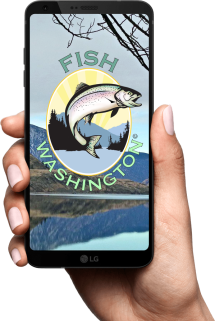
WDFW launched an upgraded version of the Fish Washington mobile application on April 9, now available to download on both Apple iOS and Android devices. The new version is designed to run more smoothly while using less data and device memory.
Developers completely rewrote the app’s code, which now features a single code base for both iOS and Android platforms. This means a smaller app size, less frequent updates, and fewer bugs. Other improvements include:
- Location-enabled United States Geological Service (USGS) river gauges.
- More consistent emergency regulation delivery.
- Map upgrades.
The new version shows the full water body name and description on emergency regulation cards. With a data connection, the app also includes National Oceanic and Atmospheric Association (NOAA) tidal predictions for marine waters and portions of the Columbia River, as well as river gauges from multiple data providers. Users can ask questions, make suggestions, or report issues by emailing MobileAppDev@dfw.wa.gov. Learn more in our news release.
WDFW phases out recreational fishing and shellfishing hotlines
For several decades, WDFW provided phone hotlines where people could listen to prerecorded messages about fishing seasons and rule changes. In the years since we established the hotlines, WDFW launched several new options to find accurate, up-to-date fishing information. We are phasing out the phone hotlines for recreational fishing and shellfishing. There are no changes to the commercial hotlines.
There are many places to find WDFW fishing regulations and information. We encourage anglers who used the prerecorded hotlines to take advantage of one of the web, mobile app, or other customer service phone options we offer. Visit our Fishing Hotlines Page to see the full list of new options and find more information.
Hunting opportunities and news
For an overview of hunting in Washington and how to get started, visit our Hunt Washington blog post.
2024-25 Hunting Regulations
The 2024 Big Game Hunting Regulations and 2024-25 Game Bird and Small Game Hunting Regulations pamphlets are available online, at hundreds of license dealers around the state, and at regional WDFW offices.
Current hunting regulations are also available online at wdfw.wa.gov/hunting/regulations.
Hunting prospects now available online
Fall marks the start of hunting seasons for big game, waterfowl, and upland game birds in many areas of Washington. WDFW has released its annual hunting prospects, which provide guidance and hunting information for each district to help hunters have a successful season.
Hunters can also use the WDFW Hunt Planner web map, an interactive web tool that helps hunters find permit and general season hunts based on location, date, weapon choice, and more.
New rule in effect for bobcat hunters and trappers
Hunters and trappers must submit the lower jaw of any bobcat they harvest, as part of the mandatory pelt sealing process, following a rule update finalized through WDFW’s most recent season setting process.
WDFW uses canine teeth to determine the age structure of harvested bobcats and track changes over time. Because bobcats' canine teeth are not as easily removed as those of other species, the entire lower jaw must be submitted.
Pelts must be sealed by April 20. Visit WDFW's website for information on how to remove the lower jaw and how to request that the Department return the jaw to you after removing the canines. Contact WDFW at wildthing@dfw.wa.gov or 360-902-2515 with questions.
Big game seasons underway
Late modern firearm deer season runs from Nov. 14-17. Late muzzleloader deer season runs from Nov. 27-Dec. 15. Late archery deer season starts Nov. 27 and ends Dec. 15 or 31, depending on game management unit (GMU).
Your chance of success ramps up this month as the deer rut (mating season) gets underway and wet and stormy weather has deer up and moving.
November elk hunting
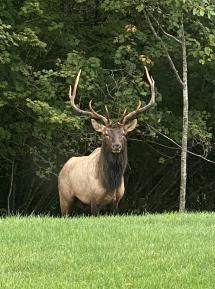
The modern firearm general elk hunting season runs Nov. 2-13 in many Western Washington GMUs. Late muzzleloader elk season starts Nov. 27 and ends Dec. 8 or 15, depending on GMU. Late archery elk season runs from Nov. 27-Dec. 15.
Primarily Roosevelt elk, with Rocky Mountain elk present in areas of the central and south Cascades, these animals travel in small herds or "bands" and tend to stick to thick cover during daylight hours.
Spending plenty of time researching, scouting, and finding where the elk are is often critical for success, as herds are typically concentrated in small areas within much larger expanses of habitat. Learn more about Roosevelt elk in our blog post.
Game transport rules to limit spread of CWD
WDFW reminds out of state hunters of restrictions on bringing deer, elk, moose, or caribou into Washington if harvested outside the state, or within the 100 series GMUs in Eastern Washington. To prevent the spread of chronic wasting disease (CWD), animals should be boned out at the site of harvest if possible. Only deboned meat, cleaned skulls, antlers, hides, and specific tissues for research or taxidermy are allowed for transport. Visit WDFW’s website for CWD information, regulations, and testing instructions.
Black bear
Fall black bear hunting runs through Nov. 15. More information including area restrictions is available in the 2024 Big Game Hunting Regulations.
Hunters are urged to not shoot a female with cubs. Bait or hounds are not allowed for bear hunting under Washington state law. Successful hunters must submit a tooth sample from their harvested bear, with instructions available at the link below.
Hunters that choose to hunt in GMUs located in grizzly bear recovery areas must successfully complete the annual WDFW online bear identification test. The online test is available through the WDFW Wild System or our Bear identification program webpage.
Cougar
Cougar hunting remains open in most GMUs through March 31 or until the 13% harvest cap is reached. Before heading out, make sure the GMU you're looking to hunt is open by calling the Cougar Hotline at 1-866-364-4868 (press 2 after greeting) or visiting WDFW's website.
Hunters may take one cougar per license year.
Please note that it is illegal to kill spotted kittens (usually less than 80 pounds) or adult cougars with spotted kittens. Observing multiple sets of tracks likely indicates a female with kittens.
Game bird seasons take flight
Migratory game birds
Statewide duck hunting runs through Jan. 26. Goose hunting is also open, with seasons varying by goose management area.
Hunters are reminded to check the migratory waterfowl regulations for specific season dates and for detailed rules and bag limits. Tens of millions of ducks and geese use the Pacific Flyway, and Washington is routinely ranked among the best states in the U.S. for waterfowl hunting, with diverse species and opportunities from coastal bays and marshes to farm fields, pothole lakes, and big rivers.
Upland game birds
Regular pheasant season continues through Nov. 30 in Western Washington, with a daily bag limit of two of either sex.
Grouse hunting seasons are open through Jan. 15. Starting in 2021, the start of this season was pushed back two weeks to reduce the harvest of breeding-age hens and ultimately increase forest grouse abundance and availability for hunters.
Photographers: Enter our Big Game Hunting Pamphlet cover contest
Enter our contest by Feb. 13 for a chance to be featured on the cover of Washington's 2025 Big Game Hunting Regulations pamphlet!
This year's photo contest theme is “Hunters contributing to conservation.” We know hunters contribute to conservation by purchasing state licenses, paying the Pittman-Robertson excise tax on equipment, and helping to meet management objectives through sustained harvest. We want to see all the other ways Washington hunters support wildlife management and conservation! Whether you’re educating new hunters, volunteering on habitat improvement projects on public or private land, staying involved in local outdoor associations, or contributing in other valuable ways, we want to see your photos!
Visit our contest page for details and to submit your photo. The winner will be announced in April 2025.
New, prospective hunters must complete hunter education
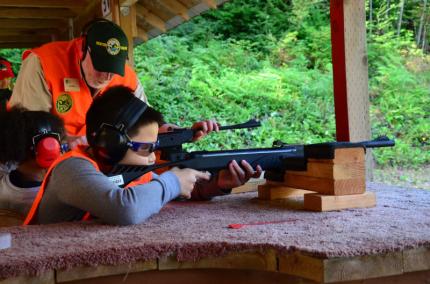
Before hunting seasons start, be sure to complete your hunter education course.
Students may choose between a traditional classroom or hybrid course. The traditional course is a multi-session instructor-led training with an average of 15 hours of instruction. The hybrid course consists of a self-paced online class followed by a field skills evaluation by certified instructors.
Prospective hunters can learn more about hunter education requirements and register for either a traditional or hybrid course by visiting WDFW’s hunter education webpage.
Per Washington state law, all hunters born after Jan. 1, 1972, must complete a hunter education course in order to buy a hunting license. A hunter education deferral is available for hunters 10 and older who want to try hunting with an eligible licensed hunter before completing a hunter education course themselves.
WDFW offers accessible hunting and wildlife-viewing blinds
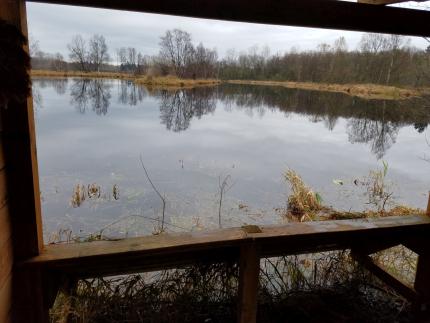
Did you know WDFW offers hunting and wildlife-viewing blinds and platforms throughout Washington that are accessible to people with disabilities? Learn about these Americans with Disabilities Act (ADA) designated sites on our ADA hunting and wildlife-viewing blinds and platforms page.
Some sites can be reserved through WDFW's Private Lands Hunting Access program. Others can be reserved by calling the wildlife area manager.
Hunters without disabilities should yield ADA hunting and wildlife-viewing blinds and platforms to those with disabilities if the site was reserved.
Many of these ADA hunting and wildlife-viewing blinds and platforms are built and maintained with support from volunteers, master hunters, and partners including Inland Northwest Wildlife Council and Washington Waterfowl Association. Thank you!
Head to myWDFW.com for info on hunting, angling, and more
WDFW has rolled out a promotional website for all things hunting, angling, foraging, recreating, and more. At myWDFW.com, you’ll find informative how-to articles on the season’s major fishing and hunting opportunities, as well as a portal to online license sales and a regular update on WDFW’s latest Life Outdoors articles.
Each quarter, new fishing and hunting highlights are posted to help you get ready and take part in Washington’s current and upcoming opportunities. Dedicated to current agency promotions, outdoor recreation information, and educational content, myWDFW.com preps you to meet with success in the field and on the water.
Wildlife watching and recreation
Find more tips on our wildlife viewing webpage.
Help wildlife stay wild: Avoid feeding!
Temperatures are dropping, and winter will be here before we know it. Some may take this as their cue to stock up on groceries to feed local wildlife, but wild animals don't need us to feed them.
There are many reasons to avoid feeding wildlife:
- Feeding wild animals causes them to lose their natural fear of people, which can lead to aggression or make them vulnerable to harm.
- It draws wildlife together, possibly mixing healthy and sick animals and spreading diseases among them. Some wildlife can carry diseases that may also be transmissible to people and pets.
- Feeding wildlife may attract carnivores such as coyotes, bears, and cougars.
- Animals may cross busy roads, risking being hit by vehicles, to get to where they are fed.
- Some wildlife cannot properly digest human-provided food, and they can get sick or even die from it.
The best way to show appreciation for wildlife is to admire them from a safe distance and allow them to stay wild! Learn more on our webpage about the risks of feeding wildlife.
Tis the season for foraging
Mushrooms are highly sought after in autumn, especially as the first major rainfalls occur in early November, and before the first frost sets in.
Top priority when gathering mushrooms is being able to identify what you’re picking before you dish it up to eat. Safety comes first, and nobody enjoys getting sick — or worse, winding up in the emergency room. Find helpful tips on mushroom gathering and identification in the WDFW blog.
Wild Washington Youth Education: Animal observation
Early season snows reveal animal tracks, hidey-holes, and other wildlife findings that might not be seen on bare ground. Additionally, seasonal changes in foliage can help kids hone observation skills. Observation and sensory activities help children make sense of how the world works and encourage critical thinking skills. For ideas, check out our nature-based mindfulness activities.
Find an accessible area to go bird watching
Birdability is a national nonprofit that works to ensure the birding community and the outdoors are welcoming, inclusive, safe, and accessible for everybody and every body.
Birdability has a crowdsourced map where the public has contributed information about accessible viewing sites. The purpose is to allow people with disabilities and other health concerns access to this information ahead of time, to help them decide if a location is one they would like to visit.
Please note that this list of accessible sites is not exhaustive and continues to be expanded — but it is another resource that can provide useful information for preparing a bird watching or other outdoor adventure. Happy birding!
Practice black bear awareness year-round
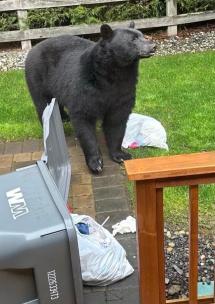
Black bears are common throughout Washington, including suburban areas. Both when preparing for hibernation and awakening from it, they look for high-calorie foods that are easy to get. These may include garbage, bird feeders (both seed and liquid), fruit trees, and pet food.
As human populations encroach on bear habitat, people and bears have greater chances of encountering each other. Food sources provided by humans, whether intentionally or not, can attract bears. Removing these attractants is the best way to encourage bears to move along and focus on natural food sources
Ask your local waste management company if bear-resistant containers are available or if individually purchased bear-resistant containers are compatible with the company’s equipment. Secure your garbage cans, such as in a shed or garage, and put them out the morning of pickup — not the night before. To help reduce odors, freeze meat and fish waste before disposing of it and spray garbage cans with disinfectants.
More information on living with bears is available on our black bear webpage and our black bear two-pager (PDF).
Conserving species and habitats
Looking for more info on wildlife conservation and species management around Washington? Check out our Bi-Weekly Wildlife Program reports.
Permitting process keeps animal welfare at the forefront of Washington wildlife rehabilitation
Washington’s permitted wildlife rehabilitators play the crucial role of caring for sick, injured, orphaned, or abandoned animals while professionally preparing them to return to the wild. To do this important work, wildlife rehabilitators in the state must obtain permits through WDFW and must be approved for the specific species they plan to rehabilitate. Animal welfare and ethics are at the forefront of the wildlife rehabilitation profession.
If you have found wildlife in need of care, contact a permitted rehabilitator as soon as possible and follow their instructions. Do not attempt to treat or raise wildlife yourself — it is illegal to hold or care for wildlife without a permit.
Currently, there are 29 wildlife rehabilitation centers in Washington with permitted and approved rehabilitators overseeing operations. Learn more about WDFW’s wildlife rehabilitation permitting process in our new blog post, or find your nearest wildlife rehabilitator through WDFW’s wildlife rehabilitation webpage.
Fall clean-up: Pick your fruit trees
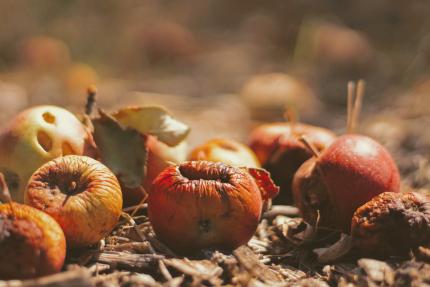
Is fruit piling up under your trees? Time for a fall clean-up!
Leaving fruit on the ground can attract rats, raccoons, and even bears. Plus, rotting fruit can spread harmful plant diseases, fungi, and parasites.
So, help out and pick up the fruit! You can compost or salvage it. To make apple cider, rent a cider press or take the fruit to a community cider pressing! Make sure to wash and inspect any windfall fruit for rot and insects before processing. Local brewing shops and conservation districts may have cider presses for rent. Community cider pressings often take place at local granges, community centers, and libraries.
Habitat at Home: Leave the leaves, but not in the street!
Leave the leaves — our friends need these!
That’s right: leaves that fall on the ground are crucial to wildlife surviving the winter. Ground-nesting pollinators and insects nest in them; amphibians and reptiles find cozy shelter in the warm, moist leaves; songbirds and small mammals use them for nests; and small mammals use leaves to keep them warm through the winter.
Can’t leave the leaves? Create small leaf piles around your yard; these mini hideaways make a big difference.
Avoid blowing leaves from your yard into the street. They can clog drains, which can lead to flooding. As streets flood, harmful chemicals build up in the water and rush into local streams and lakes. These chemicals ultimately harm the wildlife that depend on these water sources.
What can you do to help? Regularly clear your street drains of leaves and debris, and put those leaves in your garbage can, rather than compost.
Community Habitat signs are now available
Do you have wildlife habitat in your neighborhood, apartment courtyard, business front, schoolyard, or community center? Whether it’s a small garden or a larger area, if it provides a home for wildlife, we want to celebrate it!
Apply online and we’ll send you a free Habitat at Home Community Spaces sign along with resources to help steward the habitat.
To qualify, your space should:
- Be accessible to your community.
- Provide food, water, shelter, and space for wildlife.
- Feature native plants.
Join the WDFW team
If you’d enjoy preserving, protecting, and perpetuating the state’s fish, wildlife, and ecosystems while providing sustainable fish and wildlife recreational and commercial opportunities, then check out some of our current job openings or sign up for job alerts. From fish hatchery specialists to environmental engineers and budget analysts to wildlife biologists, a career with WDFW makes a difference.
Volunteer opportunity spotlight
WDFW welcomes volunteers of all abilities who want to contribute to the conservation of fish, wildlife, and habitat. Diverse volunteer opportunities are available, including projects on state wildlife areas and water access areas, habitat restoration projects, hunter education instruction, and assisting at outreach events.
For more information about the volunteer program and upcoming volunteer opportunities, visit the WDFW volunteer webpage.
Wildlife Program biweekly reports
To read reports published prior to 2023, visit the Biweekly Wildlife Program activity reports page.
2024
Regional Director: Heather Hall
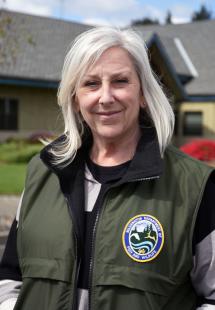
Heather Hall started in her role as Coastal Washington (Region 6) Director on May 1, 2024.
Heather is excited to return to Region 6, where she began her career at WDFW in 1995. Most recently, she served as Intergovernmental Ocean Policy Manager, overseeing state fisheries and fisheries extending into federal waters.
Heather is committed to public service. She brings expertise to her new role ranging from fieldwork to policymaking, giving her a unique perspective on fish and wildlife management in the Coastal Region.
Heather holds a bachelor’s degree in science from Western Washington University. In her free time, she enjoys recreating along the Washington coast, including kayaking, standup paddleboarding, crabbing, and gathering oysters on Hood Canal.






















